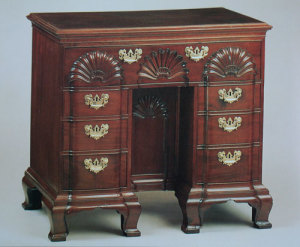 Technical examinations of a piece of furniture are undertaken to document the history of an object and to determine the source of various conditions and how to successfully treat them. They can also be critical to documenting the authenticity of an object.
Technical examinations of a piece of furniture are undertaken to document the history of an object and to determine the source of various conditions and how to successfully treat them. They can also be critical to documenting the authenticity of an object.
Inscriptions are coveted for their ability to bring insight into the manufacture and ownership of objects for attribution purposes. Often, however, they were made quickly for the maker’s use with fugitive or easily removed materials such as chalk. This knee-hole desk from c. 1760-90 had been in the collection of the State Department’s Diplomatic Reception Rooms for many years, and had been attributed to a maker in the prolific Rhode Island Goddard-Townsend family of cabinetmakers.
During an on-site examination, conservator Thom Gentle observed an inscription, but it was both very hard to see with the naked eye and partially covered by an added glue block. Once the block was carefully removed by our staff, the inscription was photographed with an infrared filter. This technique visualizes the relative heat absorption the wood and the writing material, not just their color, to create a high contrast image that makes the inscription more legible. This inscription reads: “Thomas Townsend of Newport Son of Job Townsend deceased of Newport” and identifies it as being made by the youngest son Thomas, who has only one other piece of furniture identified by a label.
